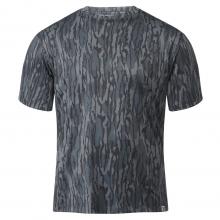Mark Davis from Lexington, South. Carolina, uses his Pure Bay boat to fish from Montauk, New York, to Brownsville, Texas, for all saltwater species. Each year, Davis films seven shows in the U.S. and six shows from destinations all over the world for his TV show, “Big Water Adventures” on the Outdoor Channel. Davis has been on the Outdoor Channel for 11 years, and he's filming for year 12 right now and is a member of the Mossy Oak Fishing Team.

Catching fish is easy. That’s the easiest part of my job. Catching fish is only about five percent of my job, because in saltwater fishing, success is about timing. What time will the tide come in, and what time will the tide go out? Where are the fish supposed to be at this time of the year? The right water temperature and the correct air temperature are important, too. When you're fishing in salt water, if you're where the fish are, when the fish are there, the fish aren’t that hard to catch.
Inshore fishing is usually easier than offshore fishing because it’s closer to land. I’d have to go out of the country to make an inshore fishing trip difficult. For instance, if I'm fishing for bull reds in Venice, Louisiana, and a storm comes up, I simply can wait the storm out and continue to fish. If a hurricane comes through, I can reschedule that trip for later in the year. The most difficult part of my job as a TV host and producer is getting to the locations where we want to produce a TV show when the fish are supposed to be at a specific place.
My toughest inshore fishing trip ever was catching tarpon inshore in Trinidad, the farthest island south in the Caribbean that’s just off the coast of Venezuela. Trinidad has some of the best tarpon fishing in the world, but the big problem is getting to Trinidad when the tarpon come inshore. I tried to get to Trinidad three different times.
The element that made that this trip so difficult was flying there, because the airlines put a moratorium on the amount of gear we could carry. As a TV production crew, we needed a lot of gear to make a TV show. Also, the airlines put weight restrictions on travel. You couldn’t carry but a specified amount of weight, and our gear weighed more than that.
When we finally got to Trinidad at the right time when the tarpon were in, we caught 28 tarpon in two days and each tarpon weighed from 100 to 170 pounds. We got the leaders in our hands each time, which is considered a catch, and we released all 28 tarpon.

Trinidad is a 12-month tarpon fishery. Trinidad has sold its offshore fishing rights to China, and since tarpon is a non-food fish, the island homes plenty of them. The Chinese have caught pretty much all the edible fishes, and nothing’s left but baitfish and tarpon. This is why the tarpon fishing is so good. A bad day of tarpon fishing in Trinidad is only catching six to eight tarpon. Without question, Trinidad is the no. 1 tarpon fishing destination in the world. The fishing was so good that I was catching 150-pound tarpon that would come up and eat a topwater lure.
You can keep up with Mark Davis’ fishing adventures at http://www.bigwateradventures.com.





























